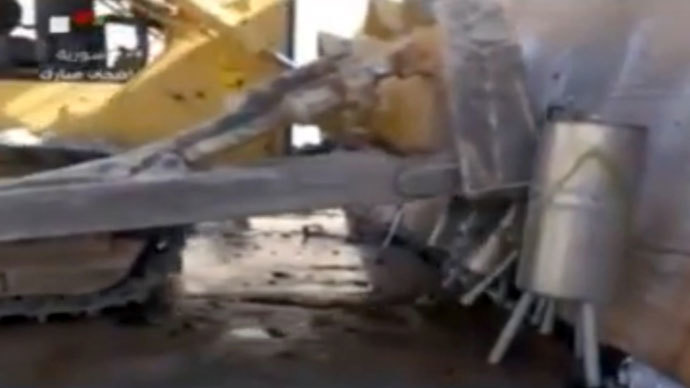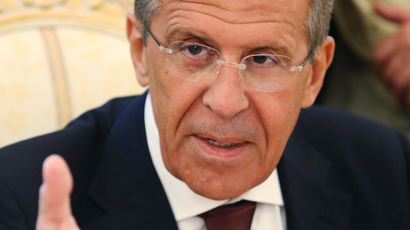Destruction of Syrian chemical weapons a ‘milestone’ but more can be done – UN watchdog to RT

The Syrian government has reached a milestone by meeting its “extremely important” November 1 deadline for the destruction of its listed chemical weapons and mixing and filling facilities, OPCW spokesman Michael Luhan told RT.
Syrian authorities “functionally destroyed the critical equipment
which is needed to run their chemical weapons production
facilities. All of that has now been rendered inoperable,”
Michael Luhan, spokesman for the Organisation for the Prohibition
of Chemical Weapons (OPCW), told RT on Thursday.
“This was an extremely important deadline and a milestone that
we’ve reached,” he added.
OPCW experts have so far visited 21 out of 23 chemical weapons
sites across Syria. The two remaining facilities are currently
too dangerous to visit due to military action between government
forces and Islamist rebels.
According to the watchdog, chemical equipment from the unvisited
facilities was moved to sites where the inspections were
performed.
Syria also complied with another target date by submitting
“the initial declaration of their entire program and its
components as well as their general plan for destruction” to
the OPCW last week, Luhan said.

The next step in the disarmament process is the elimination of
Assad’s chemical stockpile, which must be completed by June 30,
2014.
The plan to “irreversibly destroy” the entire weapons
program and all related materials must be approved by the OPCW’s
executive council by November 15, the spokesman stressed.
Assad’s government agreed to give up its chemical arsenals as
part of the US-Russia brokered deal which prevented Washington
from using military force against Syria.
Despite failing to provide any proof that Assad’s government was
behind the August 21 chemical attack in a Damascus suburb, the US
said that Syrian authorities must be punished for staging the
sarin gas attack, which left hundreds dead.
The Syrian government, which has denied all accusations, has
provided “all of the cooperation…that has been required for us
to conduct our verification activities,” Luhan said.
He also praised the “the invaluable support that we [OPCW
inspectors] have received from the UN mission in Damascus,
without which we can’t operate the country. It’s the United
Nations that has been looking after the safety and security of
our inspectors, together with the senior government, and which
has enabled us to register this achievement.”
He went on to commend the work of the OPCW for the progress it
has made.
“There was a lot of skepticism that we would be able to reach
the point that we’ve reached today of putting out of commission
those chemical weapons production facilities and mixing and
filling plants. So, we’re doing a lot better than a lot of people
would’ve expected in the outset,” he said.
Luhan stressed the importance of waiting until the November 15
decision, as “right now it’s a little bit early to speculate
on the arrangements that are going to be made to get on with the
destruction of the stockpile.”
He said that he has not excluded the possibility that “some of
the stockpile may have to be moved out of the country to a safer
location where it can be destroyed using incineration or
hydrolyzation, a method that’s used to destroy chemical weapons
agents.”
“But we’re not there yet,” he added.
Syria’s civil war, which has been raging since March 2011, has
claimed the lives of over 100,000 people, according to a recent
UN estimate.














